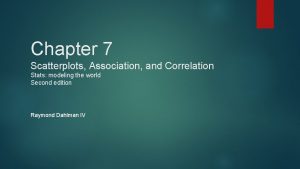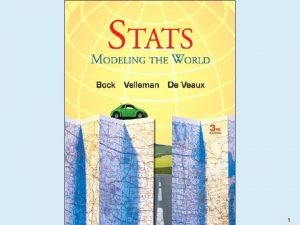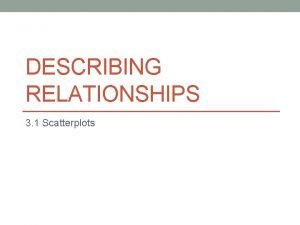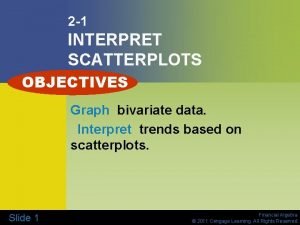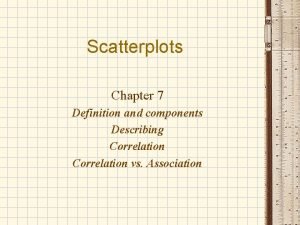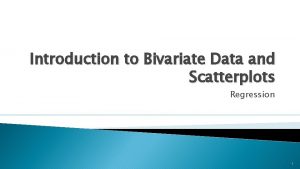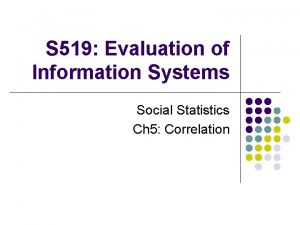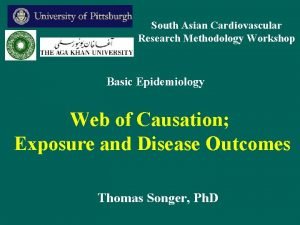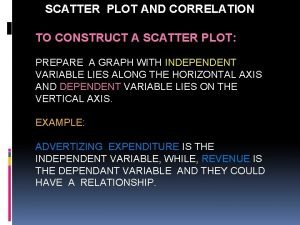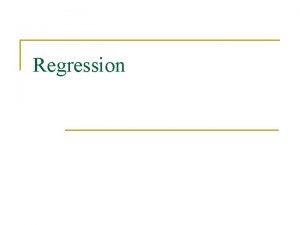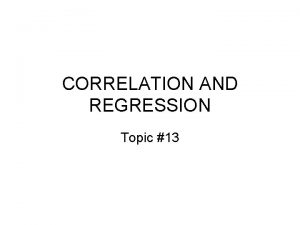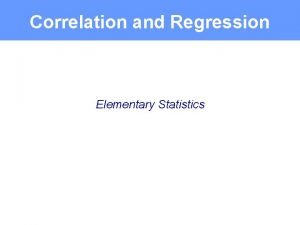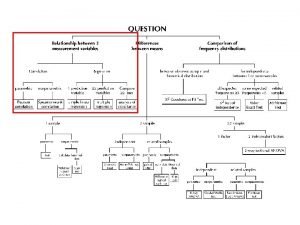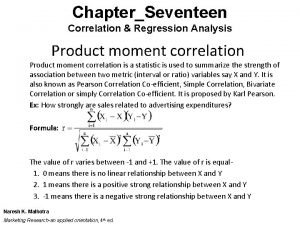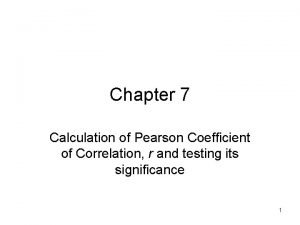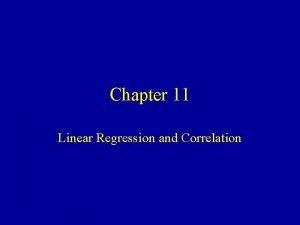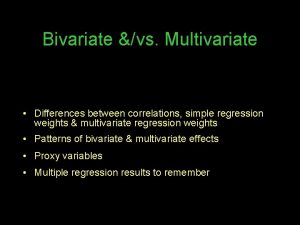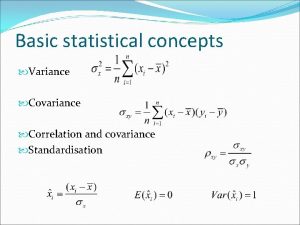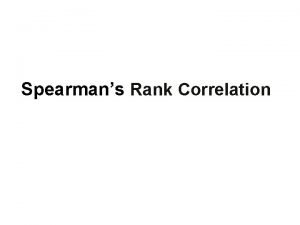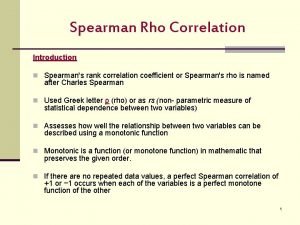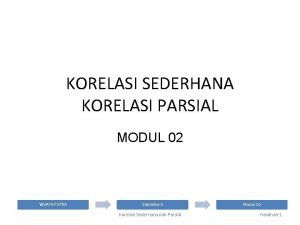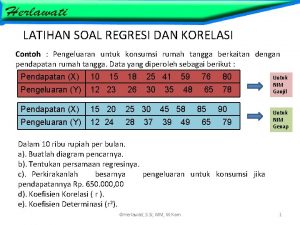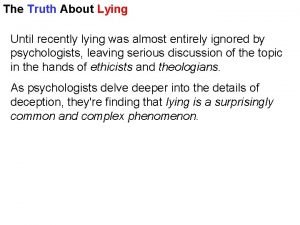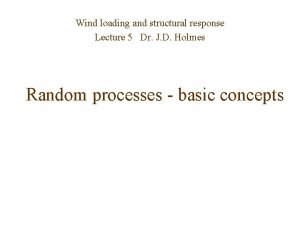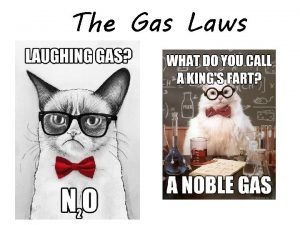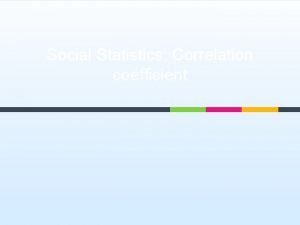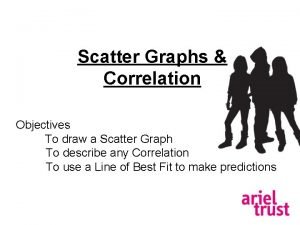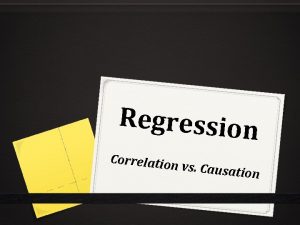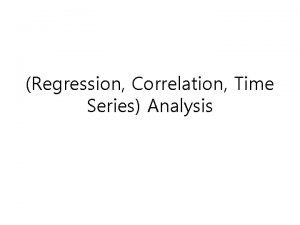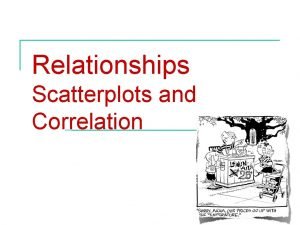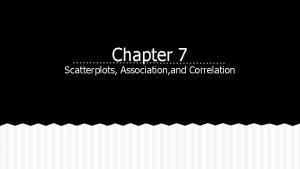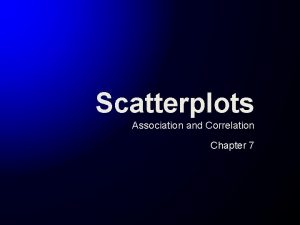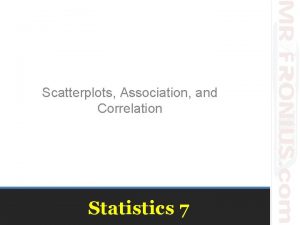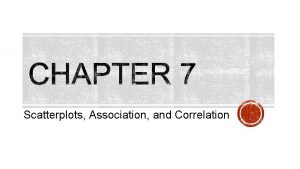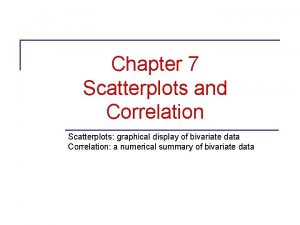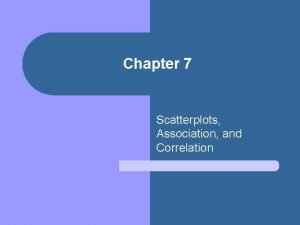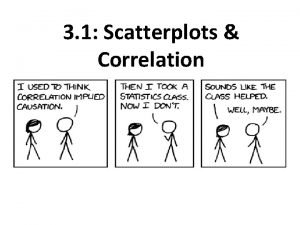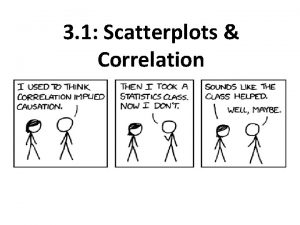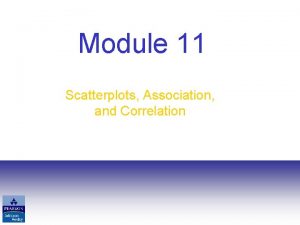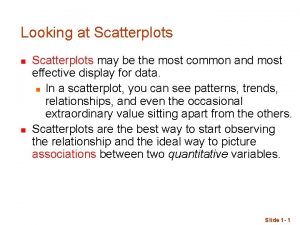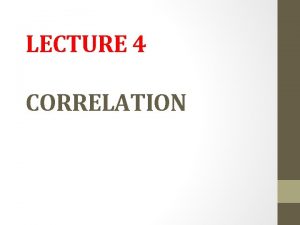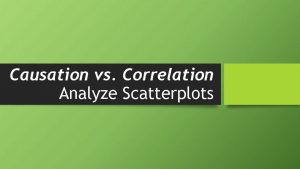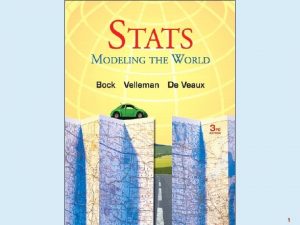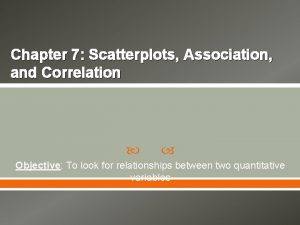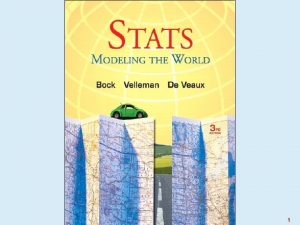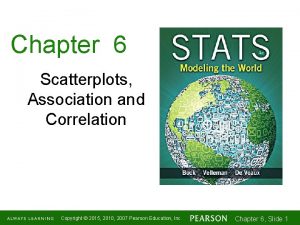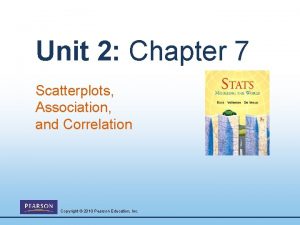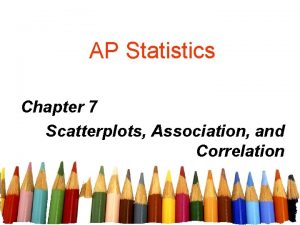Scatterplots Association and Correlation Chapter 6 Looking at












































- Slides: 44

Scatterplots, Association, and Correlation Chapter 6

Looking at Scatterplots • Scatterplots can help you can see patterns, trends, relationships, and even the occasional extraordinary value sitting apart from the others. • Scatterplots are the ideal way to picture associations between two quantitative variables.

Looking at Scatterplots (cont. ) • When describing scatterplots, we will always mention direction, form, strength, and unusual features.

• Direction: • A pattern that runs from the upper left to the lower right is said to have a negative direction. • A trend running the other way has a positive direction.

Can the National Hurricane Center predict where a hurricane will go? • What type of direction is this? • The figure shows a negative direction between the year since 1970 and the prediction errors. • As the years have passed, the predictions have improved (errors have decreased).

• • What direction is this? • As the central pressure increases, the maximum wind speed decreases. This example shows a negative association between central pressure and maximum wind speed

Form: If there is a linear relationship, it will appear as a swarm of points stretched out in a generally consistent, straight form.

Form: If the relationship curves, while still increasing or decreasing steadily, we can often find ways to make it more nearly straight (this is for later)

Form: If the relationship curves sharply, the methods of this book cannot really help us.

Strength • You may see that the points appear to follow a single stream (whether straight, curved, or bending all over the place).

Strength • The points may also appear as a vague cloud with no discernable trend or pattern: • Note: we will quantify the amount of scatter soon.

Unusual Features: • Look for the unexpected. • Like an outlier standing away from the overall pattern of the scatterplot. • Clusters or subgroups should also raise questions.

Roles for Variables • • • It is important to determine which of the two quantitative variables goes on the x-axis and which on the y-axis. The explanatory or predictor variable goes on the x-axis. The response variable (variable of interest) goes on the -axis. y

Roles for Variables (cont. ) • The roles that we choose for variables are more about how we think about them. • Just placing a variable on the x-axis doesn’t necessarily mean that it explains or predicts anything. And the variable on the y-axis may not respond to it in any way.

Data collected from students in Statistics classes included their heights (in inches) and weights (in pounds): Describe the graph using direction, form, shape, and any unusual features. Here we see a positive association and a fairly straight form, although there seems to be a high outlier.

Correlation • How strong is the association between weight and height of Statistics students? • If we had to put a number on the strength, we would not want it to depend on the units we used. • A scatterplot of heights (in centimeters) and weights (in kilograms) doesn’t change the shape of the pattern:

• Since the units don’t matter, why not remove them altogether? • We could standardize both variables by finding the z-score of all values. • We would now write the coordinates of a point as (zx, zy) instead of (x, y). • Here is a scatterplot of the standardized weights and heights: • The center of the new scatterplot is now at the origin.

• Equal scaling gives a neutral way of drawing the scatterplot and a fairer impression of the strength of the association.

• Some points (those in green) strengthen the impression of a positive association between height and weight. • Other points (those in red) tend to weaken the positive association. • Points with z-scores of zero (those in blue) don’t vote either way.

APSTATSGUY • Video 5 minutes to 8 minutes • https: //www. youtube. com/watch? v=Xe 31 NQ-BQT 4

• For the students’ heights and weights, the correlation is 0. 644. • What does this mean in terms of strength?

Correlation Conditions • Correlation measures the strength of the linear association between two quantitative variables. • Before you use correlation, you must check several conditions: 1) Quantitative Variables Condition 2) Straight Enough Condition 3) Outlier Condition

1) Quantitative Variables Condition: • Correlation applies only to quantitative variables. • Don’t apply correlation to categorical data. • Check that you know the variables’ units and what they measure.

2) Straight Enough Condition: • You can calculate a correlation coefficient for any pair of variables. • But correlation measures the strength only of the linear association, and will be misleading if the relationship is not linear.

3) Outlier Condition: • Outliers can distort the correlation dramatically. • An outlier can make an otherwise small correlation look big or hide a large correlation. • It can even give an otherwise positive association a negative correlation coefficient (and vice versa). • When you see an outlier, it’s often a good idea to report the correlations with and without the point.

• The sign of a correlation coefficient gives the direction of the association. • Correlation is always between – 1 and +1. • Correlation can be exactly equal to – 1 or +1, but these values are unusual in real data because they mean that all the data points fall exactly on a single straight line. • A correlation near zero corresponds to a weak linear association.

• Correlation treats x and y symmetrically: • The correlation of x with y is the same as the correlation of y with x. • Correlation has no units. • Correlation measures the strength of the linear association between the two variables. • Variables can have a strong association but still have a small correlation if the association isn’t linear.

Classwork/Homework: 1) Pg 167 – 171, Ex: 2, 4, 5, 7 – 10, 16, 19, 21, 33 2) Read Chapter 6 3) Work on Guided Reading

Correlation ≠ Causation • Whenever we have a strong correlation, it is tempting to say the predictor variable has caused the response. • Scatterplots and correlation coefficients never prove causation.

Lurking Variables • A hidden variable that stands behind a relationship and affects the other two variables is called a lurking variable. • You can often trash claims made about data by finding a lurking variable behind the scenes.

Question (5 minutes) • Over the past decade, there has been a strong positive correlation between teachers salaries and prescription drug cost. • a) Do you think that paying teachers more causes prescription drugs to cost more? Explain. • b) What lurking variables might be causing the increase in one or both of the variables? Explain.

Correlation Tables • It is common in some fields to compute the correlations between each pair of variables and arrange these correlations in a table.

Straightening Scatterplots • Straight line relationships are the ones that we can measure with correlation. • When a scatterplot is curved, we can often straighten the form by re-expressing one or both variables.

Straightening Scatterplots (cont. ) A scatterplot of f/stop vs. shutter speed shows a bent relationship:

Straightening Scatterplots (cont. ) Re-expressing f/stop vs. shutter speed by squaring the f/stop values straightens the relationship:

Classwork: • Graphing Scatterplots and finding the correlation • Graphing Scatterplots and straightening a curve.

Classwork/Homework: 1) Pg 169 – 175, Ex: 11, 17, 29, 36, 38, 42, 47 2) Read Chapter 6 3) Complete Guided Reading 5) Chapter 6 Quiz (tomorrow)

What Can Go Wrong? • Don’t say “correlation” when you mean “association. ” • The word “correlation” should be reserved for measuring the strength and direction of the linear relationship between two quantitative variables.

What Can Go Wrong? • Don’t correlate categorical variables. • Be sure to check the Quantitative Variables Condition. • Don’t confuse “correlation” with “causation. ” • Scatterplots and correlations never demonstrate causation. • These statistical tools can only demonstrate an association between variables.

What Can Go Wrong? • Be sure the association is linear. • There may be a strong association between two variables that have a nonlinear association.

What Can Go Wrong? • Don’t assume the relationship is linear just because the correlation coefficient is high. n Here the correlation is 0. 979, but the relationship is actually bent.

What Can Go Wrong? • Beware of outliers. • Even a single outlier can dominate the correlation value. • Make sure to check the Outlier Condition.

• • What have we learned? We examine scatterplots for direction, form, strength, and unusual features. Although not every relationship is linear, when the scatterplot is straight enough, the correlation coefficient is a useful numerical summary. • The sign of the correlation tells us the direction of the association. • The magnitude of the correlation tells us the strength of a linear association. • Correlation has no units, so shifting or scaling the data, standardizing, or swapping the variables has no effect on the numerical value.

What have we learned? • Doing Statistics right means that we have to Think about whether our choice of methods is appropriate. • Before finding or talking about a correlation, check the Straight Enough Condition. • Watch out for outliers! • Don’t assume that a high correlation or strong association is evidence of a cause-and-effect relationship—beware of lurking variables!
 Chapter 7 scatterplots association and correlation
Chapter 7 scatterplots association and correlation Chapter 7 scatterplots association and correlation
Chapter 7 scatterplots association and correlation Looking out/looking in
Looking out/looking in Looking out looking in chapter 9
Looking out looking in chapter 9 Negative and positive correlation
Negative and positive correlation Positive correlation versus negative correlation
Positive correlation versus negative correlation Describing scatterplots
Describing scatterplots 2-1 interpret scatterplots answer key
2-1 interpret scatterplots answer key Association vs correlation
Association vs correlation Introduction to bivariate data
Introduction to bivariate data Correlation vs association
Correlation vs association Correlation vs association
Correlation vs association Beggs and brill flow regime map
Beggs and brill flow regime map Eq and iq correlation
Eq and iq correlation Scatter plot and correlation
Scatter plot and correlation Difference between regression and correlation
Difference between regression and correlation Shoe size vs height data
Shoe size vs height data Sxsi volume of correlation
Sxsi volume of correlation R squared to correlation coefficient
R squared to correlation coefficient 230-220 x 1/2
230-220 x 1/2 Pearson correlation coefficient
Pearson correlation coefficient Difference between regression and correlation
Difference between regression and correlation Ssyy formula
Ssyy formula Prediction interval formula
Prediction interval formula Difference between correlation and regression
Difference between correlation and regression Difference between correlation and regression
Difference between correlation and regression Correlation variance
Correlation variance Difference between spearman and pearson correlation
Difference between spearman and pearson correlation Spearman correlation calculator
Spearman correlation calculator Rumus korelasi sederhana
Rumus korelasi sederhana Regresi adalah
Regresi adalah Lady in the looking glass analysis
Lady in the looking glass analysis Planning is looking
Planning is looking Looking for richard stream
Looking for richard stream How to tell if someone is lying
How to tell if someone is lying Load response correlation
Load response correlation Tabel spearman rho
Tabel spearman rho Limitations of mental rehearsal
Limitations of mental rehearsal Examples of naturalistic observation
Examples of naturalistic observation Charles law indirect or direct
Charles law indirect or direct Trc reading
Trc reading T-test for correlation
T-test for correlation Line of best fit
Line of best fit Causatio
Causatio Durbin watson test interpretation
Durbin watson test interpretation
